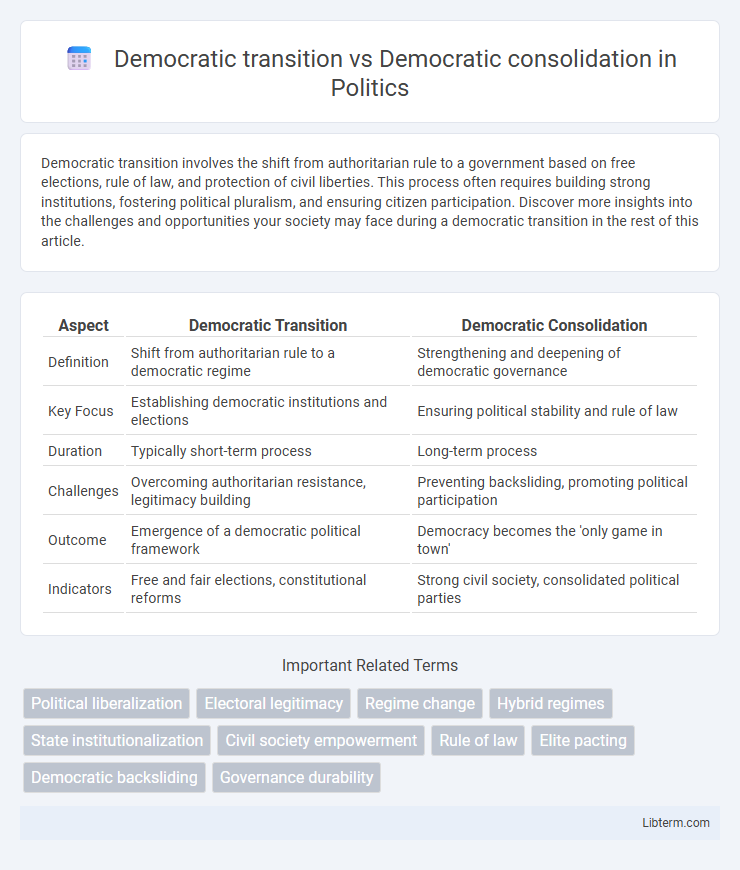Democratic transition involves the shift from authoritarian rule to a government based on free elections, rule of law, and protection of civil liberties. This process often requires building strong institutions, fostering political pluralism, and ensuring citizen participation. Discover more insights into the challenges and opportunities your society may face during a democratic transition in the rest of this article.
Table of Comparison
| Aspect | Democratic Transition | Democratic Consolidation |
|---|---|---|
| Definition | Shift from authoritarian rule to a democratic regime | Strengthening and deepening of democratic governance |
| Key Focus | Establishing democratic institutions and elections | Ensuring political stability and rule of law |
| Duration | Typically short-term process | Long-term process |
| Challenges | Overcoming authoritarian resistance, legitimacy building | Preventing backsliding, promoting political participation |
| Outcome | Emergence of a democratic political framework | Democracy becomes the 'only game in town' |
| Indicators | Free and fair elections, constitutional reforms | Strong civil society, consolidated political parties |
Understanding Democratic Transition: Key Concepts
Democratic transition refers to the process through which an authoritarian regime transforms into a democratic system, marked by free elections, political pluralism, and the establishment of civil liberties. Key concepts include regime change, political liberalization, and the participation of diverse social groups in the political process. Understanding these elements is essential to distinguish transition phases from democratic consolidation, where democracy becomes stable and institutionalized.
Defining Democratic Consolidation
Democratic consolidation refers to the process by which a new democracy matures, becoming stable and unlikely to revert to authoritarianism. It involves the widespread acceptance of democratic norms, institutionalization of political processes, and adherence to rule of law. Unlike democratic transition, which marks the initial shift from authoritarian rule to democracy, democratic consolidation ensures the durability and legitimacy of democratic governance over time.
Core Differences Between Transition and Consolidation
Democratic transition refers to the initial process of shifting from an authoritarian regime to a democratic system, often marked by first free elections and fundamental institutional changes. Democratic consolidation involves the deepening and institutionalization of democracy, ensuring stability, rule of law, protection of rights, and widespread political participation over time. Core differences include the transition's focus on regime change and election processes, while consolidation emphasizes the durability and legitimacy of democratic governance.
Historical Case Studies: Transition vs Consolidation
The democratic transition in South Africa marked the end of apartheid and the first free elections in 1994, establishing a new constitutional order but facing challenges in institutionalizing democracy. In contrast, Spain's democratic consolidation after Franco's death in 1975 demonstrated the successful embedding of democratic norms through legal reforms and political stability, preventing regression to authoritarianism. Historical case studies reveal that while transitions involve regime change and new democratic beginnings, consolidation requires deepening democratic practices and resilient institutions to secure long-term democracy.
Factors Influencing Democratic Transition
Democratic transition involves the shift from an authoritarian regime to a democratic system, influenced by factors such as economic development, civil society strength, and international pressure. Political elite negotiations, institutional reforms, and social mobilization play critical roles in initiating this change. Successful transitions depend on the interplay between internal demands for democracy and external incentives promoting democratic governance.
Challenges in Achieving Democratic Consolidation
Democratic consolidation faces challenges such as weak political institutions, pervasive corruption, and lack of public trust, which hinder the establishment of stable democratic governance. Socioeconomic inequalities and unresolved ethnic or sectarian divisions exacerbate tensions, undermining democratic norms and participation. Frequent political instability and threats from authoritarian remnants also disrupt the deepening of democratic practices essential for consolidation.
Role of Institutions in Democratic Development
Institutions play a critical role in democratic development by providing the frameworks necessary for both democratic transition and democratic consolidation. During the democratic transition, institutions such as electoral commissions and transitional justice bodies facilitate fair political competition and legitimacy, enabling peaceful power shifts. For democratic consolidation, robust institutions--independent judiciaries, accountable legislatures, and transparent electoral systems--entrench democratic norms by ensuring accountability, protecting civil liberties, and preventing authoritarian backsliding.
Public Participation: Transition and Consolidation Compared
Democratic transition involves the initial shift from authoritarian rule to a democratic system, marked by limited but growing public participation as citizens begin to engage in elections and civic activities. Democratic consolidation deepens this engagement, embedding public participation through sustained political involvement, active civil society, and institutional trust that support democratic norms. High levels of voter turnout, widespread civic education, and robust grassroots movements are key indicators distinguishing consolidation from transition in public participation.
Indicators of Successful Democratic Consolidation
Democratic consolidation is measured through indicators such as the durability of democratic institutions, widespread political participation, and the effective rule of law ensuring accountability and civil liberties. Indicators include the regular conduct of free and fair elections, the existence of a pluralistic political culture, and the resolution of conflicts through democratic mechanisms rather than violence. Successful democratic consolidation requires that all significant factions accept democracy as the legitimate system of governance, minimizing the risk of authoritarian regression.
Policy Implications for Emerging Democracies
Democratic transition marks the initial shift from authoritarian rule to electoral democracy, requiring policies that establish free elections, protect political rights, and build institutional frameworks. Democratic consolidation involves strengthening these institutions to ensure political stability, rule of law, and effective governance, necessitating policies that enhance judicial independence, media freedom, and civil society participation. Emerging democracies must prioritize legal reforms and capacity-building measures to prevent democratic backsliding and promote sustainable political development.
Democratic transition Infographic

 libterm.com
libterm.com